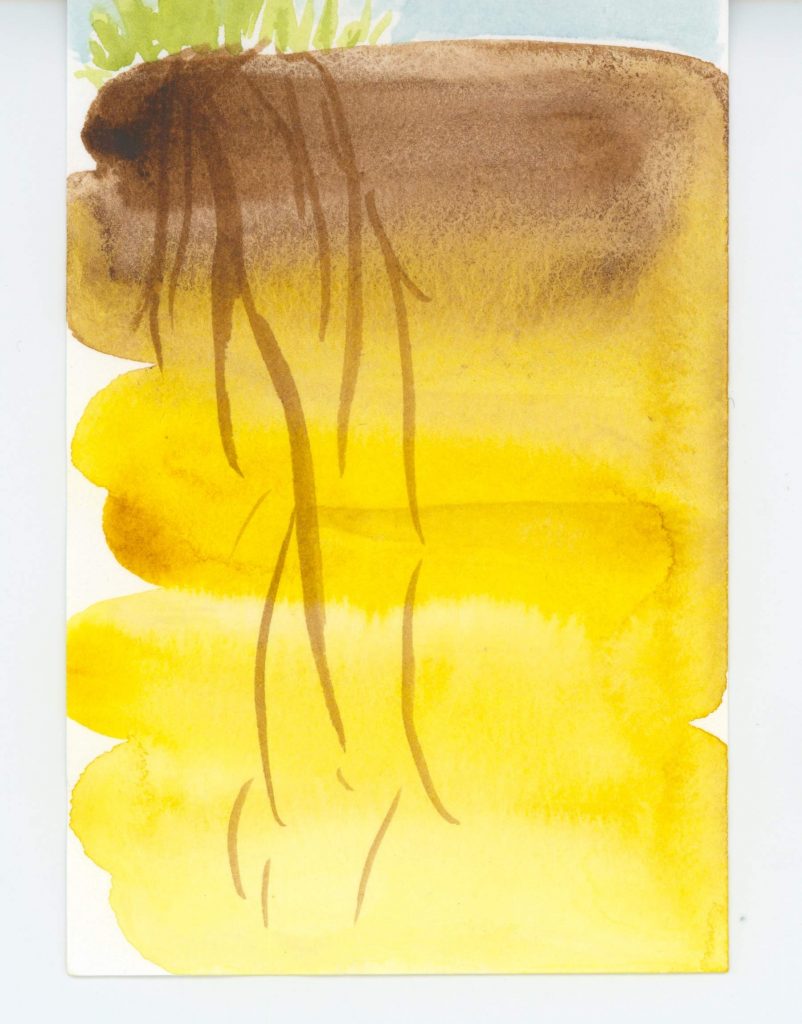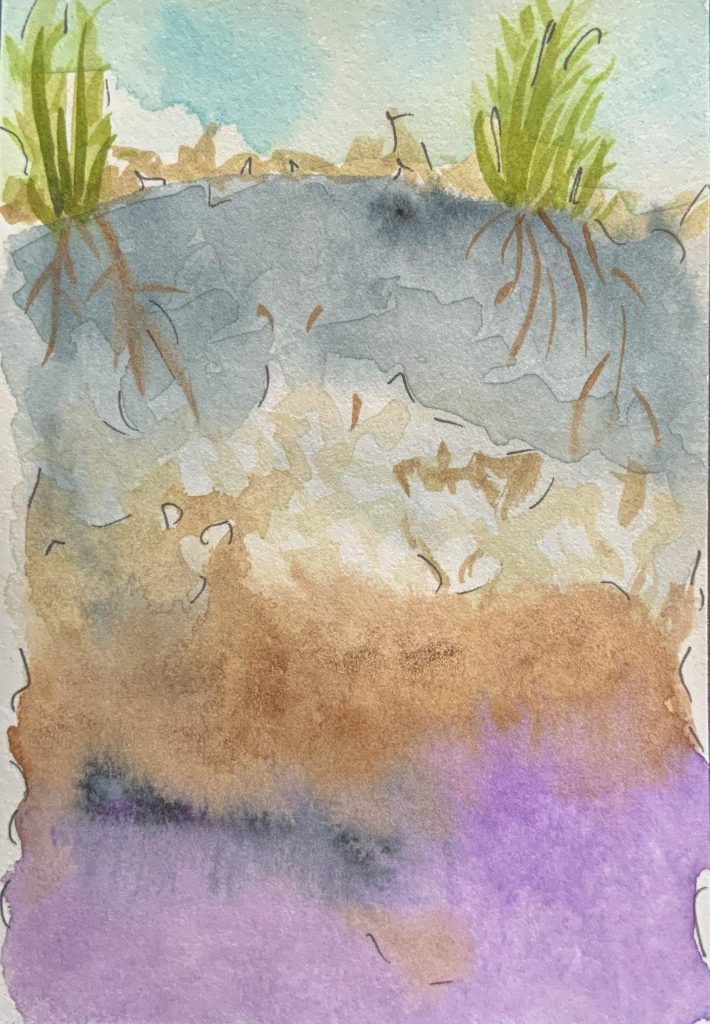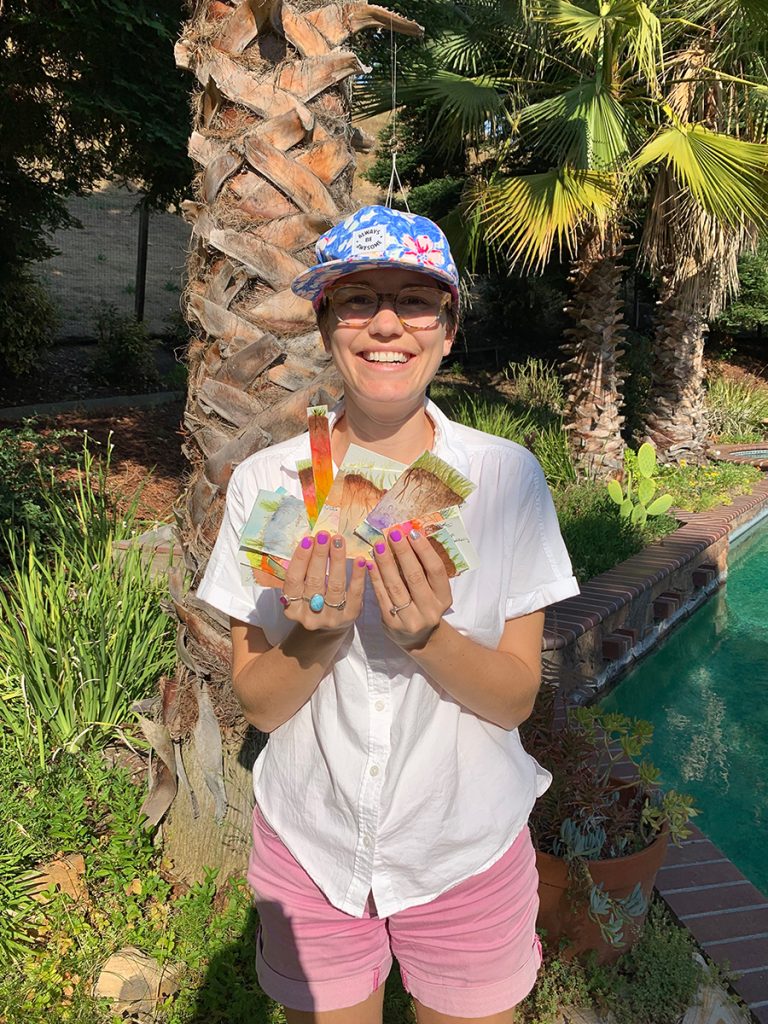Name: Yamina Pressler
Which came first in your life, the science or the art?
My first response to this question is definitely science; science came first. I identified as a scientist long before I identified as an artist. As I reflect on my journey to soil art, though, I must admit that art has been with me all along.
I grew up in my mom’s art studio and was exposed to all kinds of art media from a very young age—as long as I can remember, really. Even so, for most of my life, I never felt like I was “creative” or “artsy,” because I constantly compared my work to that of my mom’s, and it just never felt good enough. Up until I started my adventure into soil art in 2019, I would have never called myself an artist. By then, I had already received a PhD in ecology and spent almost a decade studying the soils beneath our feet. From that perspective, science came first, but the artist in me was just hidden beneath, waiting to be discovered.
“Science came first, but the artist in me was just hidden beneath, waiting to be discovered.”
Yamina Pressler



Which sciences relate to your art practice?
My art is fundamentally grounded in my work as a soil scientist. I almost exclusively paint soil profiles (a vertical exposure of a soil that shows the many horizons hidden below the surface). My paintings explore the beauty, wonder, and intrinsic value of soil. I had no idea that soils were so complex and colourful before I started studying them as an undergraduate student.
Since then, I’ve been working to show others the beauty of soil through both realistic watercolour recreations of existing soil profiles, and whimsical, colourful explorations into the idea of soil itself. The colour of soil first drew me in and drove my interest in soil science.
I now aim to harness that same sense of wonder through my art as a way to spark curiosity for soils in others. Soils are literally the basis of life on Earth. In order to protect this treasured natural wonder, we must first develop the eyes to be able to see it. That is exactly what my art is all about: giving people the eyes to see soils in a way they maybe never have before.
“Soils are literally the basis of life on Earth. In order to protect this treasured natural wonder, we must first develop the eyes to be able to see it.”
Yamina Pressler


What materials do you use to create your artworks?
I create mini soil profile paintings using a combination of high pigment watercolours; natural, small batch, soil-based pigments created by Karen Vaughan; and fine black pen. I paint on small sheets (2.5 x 3.75 inches) of assorted styles of Legion paper, and sometimes inside a watercolour notebook. I am exploring larger formats, but I especially love the mini format because it allows me to paint many soil profiles in varied styles in a single session. I view creating these paintings as a process, so I may paint 20 in one sitting and end up falling in love with one or two of them. I am drawn to the mini format because I am able to move through paintings quickly which helps prevent me from worrying too much about any one painting, but rather focus on, and enjoy, the process.
Artwork/Exhibition you are most proud of:
My first art show was at the Soil Science Society of America Soil in Art, Art with Soil exhibit in San Antonio, Texas in 2019. This was the first time I had displayed or sold my art, and it was a really special moment in time for me. At one point, I was standing at the booth with my friend, collaborator, and long time mentor, Karen Vaughan, marveling at the line of people waiting to visit with my art. It was truly surreal. My first art exhibit will only happen once, and I am so glad I had to opportunity to share the moment with my soil science community.



Which scientists and/or artists inspire and/or have influenced you?
My art is influenced most by the people in my life. Two in particular—my mom, Tina Pressler, and my friend, collaborator, and long time mentor, Karen Vaughan.
My mom is a deeply creative abstract painter and print maker. I have watched her follow her creative curiosities and pursue her art for my entire life. I am constantly inspired by her commitment to her work and by the uniqueness of her style. Some of my favorite moments recently have been spending time together painting and printing with soil-based pigments and nature-inspired shapes.
Karen was one of my early soil science professors, and she showed me how beautiful, awe-inspiring, and interesting soils are. Karen helped me realize that soils are the most precious thing that I could spend my life studying. She is also a proud “speed-dater of the arts,” as she often puts it, and through her own creative soil art musings, has encouraged me to keep putting my art out there for the world to see. I am always inspired by her willingness to try new art forms in pursuit of sharing her love for soil with the world.


Is there anything else you want to tell us?
I started painting with watercolour in 2019 in an effort to reduce my plane anxiety. I had been struggling with staying calm while flying and passively searched the internet to find strategies to reduce flight anxiety in anticipation of several upcoming trips. Somehow, I landed on a recommendation to try watercolouring. So, in secret, I bought a travel sized set of watercolour paints, a water brush, and watercolour paper. I boarded the plane, took out the paints and just gave it a try. Before I knew it, the flight was over and the only thing that came out of my brush that day was soil. Before I tried painting soil on an airplane, I never thought I was “good” at art and therefore didn’t do it. But as soon as I started to see art as a process rather than an outcome, and allowed myself to paint something just for the fun of it, everything changed. I have been painting soil profiles ever since.
“As soon as I started to see art as a process rather than an outcome, and allowed myself to paint something just for the fun of it, everything changed. I have been painting soil profiles ever since.”
Yamina Pressler

For more by Yamina Pressler, visit her website, Twitter, or Instagram.
Share this Post

